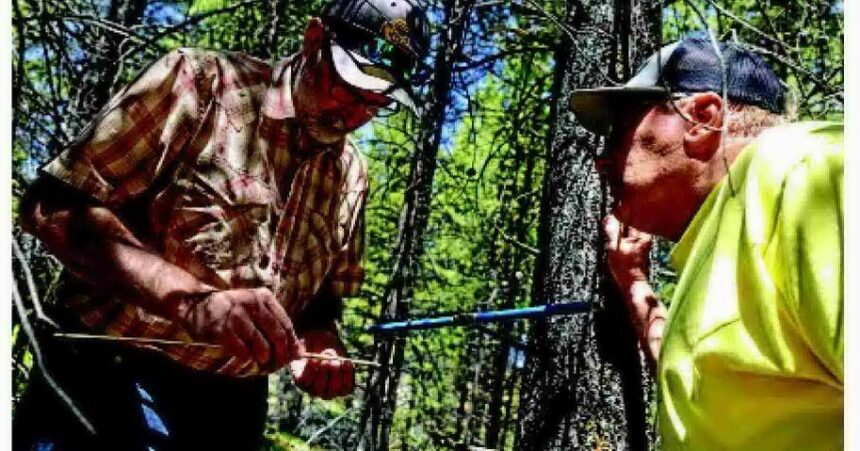The sawmill forester readily acknowledged clear-cuts rankle the senses. They appear ugly and brutal, said Sean Steinebach. But so does open-heart surgery, he said, when surgeons saw through a patient’s sternum and spread their ribs. It’s called cracking the chest.
“You have to follow up and see the aftermath,” he said.
Similar follow up is required too, Steinebach said, for clearcuts that remove broad swaths of lodgepole pines and leave especially disquieting piles of slash and a few scraggly snags for cavity-nesting birds.
“It’s messy when it’s fresh,” he said. “It’s all part of the balance. We’re just trying to keep it manageable. We are not eliminating habitats.”
Steinebach, outreach forester for Sun Mountain Lumber in Deer Lodge, and Chris Marchion, a celebrated Anaconda-based wildlife advocate, were among those collaborating in recent years to shape the Pintler Face timber project on the Beaverhead-Deerlodge National Forest.
People are also reading…
In the not-too-distant past, a commercial forester and wildlife advocate like Marchion might have been at loggerheads about any timber sale in the region of Anaconda and the Big Hole Valley.
On June 12, Steinebach and Marchion provided a tour of sections of the Pintler Face timber sale. The clear-cuts visited that day had been logged before litigation was filed earlier this year by environmental groups trying to halt additional logging or other landscape treatments.
The sections viewed included clear-cuts off the Seymour Creek Road and larger cuts off the LaMarche Creek Road in the vicinity of the foothills of the Anaconda Range and the Big Hole Valley.
The skeletal-tree aftermath of the Alder Creek Fire in 2021 could be seen across the Big Hole River from the LaMarche Creek area. The wildfire burned more than 30,000 acres during an intense fire season that also included the Trail Creek Fire near Wisdom.
‘Wildfire waiting to happen’
The Pintler Face project area is 73,624 acres and located about 10 miles northwest of Wise River on the south face of the Anaconda Range on the Beaverhead-Deerlodge National Forest.
The project would involve logging, burning or other “vegetation treatments” on about 11,224 acres. It calls for 11 miles of new but temporary roads. One of the clear-cut units on the Pintler Face project is about 375 acres; a football field is about 1.32 acres.
Marchion agreed that clearcuts can be a jarring sight. But the charred remains of a wildfire’s scorched landscape are especially galling, he said.
“Drive up on that 30,000-acre wildfire and see how well that works for you,” he said.
Marchion said sprawling, homogenous, dense stands of lodgepole pines – with many trees victims of the mountain pine beetle – are a wildfire waiting to happen. That’s one reason he worked with Steinebach and other members of the independent Beaverhead-Deerlodge National Forest Advisory Working Group to try to craft a timber sale project that showed potential to reduce wildfire risks, emulate the landscape mosaic created by natural fire and support local forest product industries — while also being designed to be sensitive to the security needs of elk and other wildlife.
“The Forest Service worked really well with us,” Marchion said.
He also complimented the participation of Vanna Boccadori, Butte-area wildlife biologist for Montana Fish, Wildlife & Parks.
Environmental analysis for the Pintler Face project began in July 2016. The Forest Service held public meetings in 2017 in Anaconda, Wisdom, Wise River, Dillon and Butte.
In February, three environmental groups filed suit in federal District Court in Missoula to try to halt the Pintler Face work. That happened well after the Forest Service greenlit the project in September 2021. Logging had begun.
‘Critic decries ‘deforestation’
One plaintiff is the Alliance for the Wild Rockies. Mike Garrity is executive director.
Garrity said the project “will basically deforest the south face of the Anaconda-Pintler Range, which is bordered by the Anaconda-Pintler Wilderness area.”
The June 12 tour of logging to date on the Pintler Face project showed no evidence of such deforestation. Even the largest clear-cuts were bordered by stands of untouched lodgepole pine. Sprawling stands of timber in areas logged decades ago remained outside the project.
Steinebach used an increment borer to estimate the age of a lodgepole in a stand near one clear-cut. He concluded the tree was about 45 years old and likely occupied ground logged about 50 years before.
“This is Michael Garrity’s worst nightmare — a healthy stand of lodgepole,” he quipped.
The Alliance for the Wild Rockies, and co-plaintiffs Native Ecosystems Council and Yellowstone to Uintas Connection, allege the Beaverhead-Deerlodge National Forest’s analysis of the project was flawed in numerous ways.
The plaintiffs were in federal court Tuesday in Missoula seeking a preliminary injunction or temporary restraining order that would halt work on the sale — which had been slated to resume in mid-July — until the court has time to fully review the plaintiffs’ February lawsuit. There was no decision Tuesday.
One key concern for plaintiffs is the potential effects of Pintler Face logging on grizzly bears, Canada lynx and wolverine, all threatened species under the Endangered Species Act.
The litigation contends the Forest Service should have completed a more thorough analysis, with either an environmental assessment (EA) or environmental impact statement (EIS), when it remapped potential lynx habitat on the Beaverhead-Deerlodge Forest in 2020. The remapping eliminated about 1.1 million acres of mapped lynx habitat on the forest.
The Alliance for the Wild Rockies prevailed in a separate lynx remapping dispute in August 2023.
The plaintiffs also allege the Forest Service’s analysis of the Pintler Face project failed to adequately consider the effects clear-cuts have on grizzly bears, of unauthorized use of existing roads and the construction of new, even-if-temporary roads.
The Forest Service should have completed a full EIS for the Pintler Face project instead of relying on an EA, the plaintiffs alleged.
In turn, the EA suggests the agency’s intent to decommission existing roads in the vicinity of the project – along with enhancing aspen, riparian and other habitats – will ultimately benefit grizzlies.
Marchion and Steinebach wondered why the plaintiffs did not help craft the Pintler Face timber sale instead of suing after logging was already underway.
The Beaverhead-Deerlodge Working Group is a citizens organization representing diverse interests – including conservation, hunting and fishing, timber, outfitters and guides, agriculture/ ranching, recreation and more. One goal is to resolve issues that might otherwise trigger litigation.
National forests are managed for multiple use. The Pintler Face decision noted that forest resources “generate employment and income in surrounding communities and counties.”
The September 2021 Forest Service decision approving the Pintler Face project acknowledged receiving objections before June 9 of that year from Alliance for the Wild Rockies and Native Ecosystems Council.
“A resolution meeting was held on July 22, 2021, with representatives from Sun Mountain Lumber and the Beaverhead-Deerlodge Working Group present,” the decision document noted. “Native Ecosystems Council and Alliance for the Wild Rockies never responded to the invitation to meet, therefore declining to attend the meeting.”
A federal website that tracks litigation shows the Alliance for the Wild Rockies has filed more than 100 lawsuits since 2007. Garrity said last week the nonprofit has prevailed in about 80% of those cases.
“They are not all timber sales,” he said.
Garrity noted the Alliance for Wild Rockies has filed lawsuits intended to benefit critical habitats for wildlife, to overturn the delisting of grizzly bears and much more.
He said he participated in years past in collaborative efforts that consumed huge amounts of time, diverting his attention from young children and a dying sister, and yielded nothing.
“Our mission is to protect habitat for native species in the Northern Rockies,” Garrity said. “It is not to support logging.”
Where does he go if he needs a two-by-four?
“I do what you do, I go to the Home Depot or Power Townsend,” Garrity said.
He noted that most wood and paper products harvested in the U.S. occur on private, not public lands. Yet sawmills like Sun Mountain Lumber rely on access to public lands in southwest Montana.
Critics of the prolific litigation filed by the Alliance for the Wild Rockies describe Garrity as an “obstructionist” whose agenda includes raising money through the award of attorney’s fees — for cases won — through the Equal Access to Justice Act.
Garrity has responded that if federal agencies did a better job he wouldn’t need to litigate.
Meanwhile, Marchion said landscapes need diversity, and the Pintler Face project was designed to restore the heterogeneity existing before fire suppression.





